Abstract
The pool size and composition of bile acids were studied in 13 unoperated patients with uncomplicated Crohn's disease; 10 patients with ulcerative colitis, and 10 normal subjects. Many patients with Crohn's disease had in their bile a significantly increased amount of ursodeoxycholic acid. The bile acid pool size was significantly decreased and the ratio of glycine to taurine conjugates was significantly increased in the Crohn's disease patients. The reduction in bile acid pool size was related to the activity of the disease. The disorders of bile acid metabolism suggest that the intestinal involvement in Crohn's disease is much more extensive than can be demonstrated by careful radiological examinations.
Full text
PDF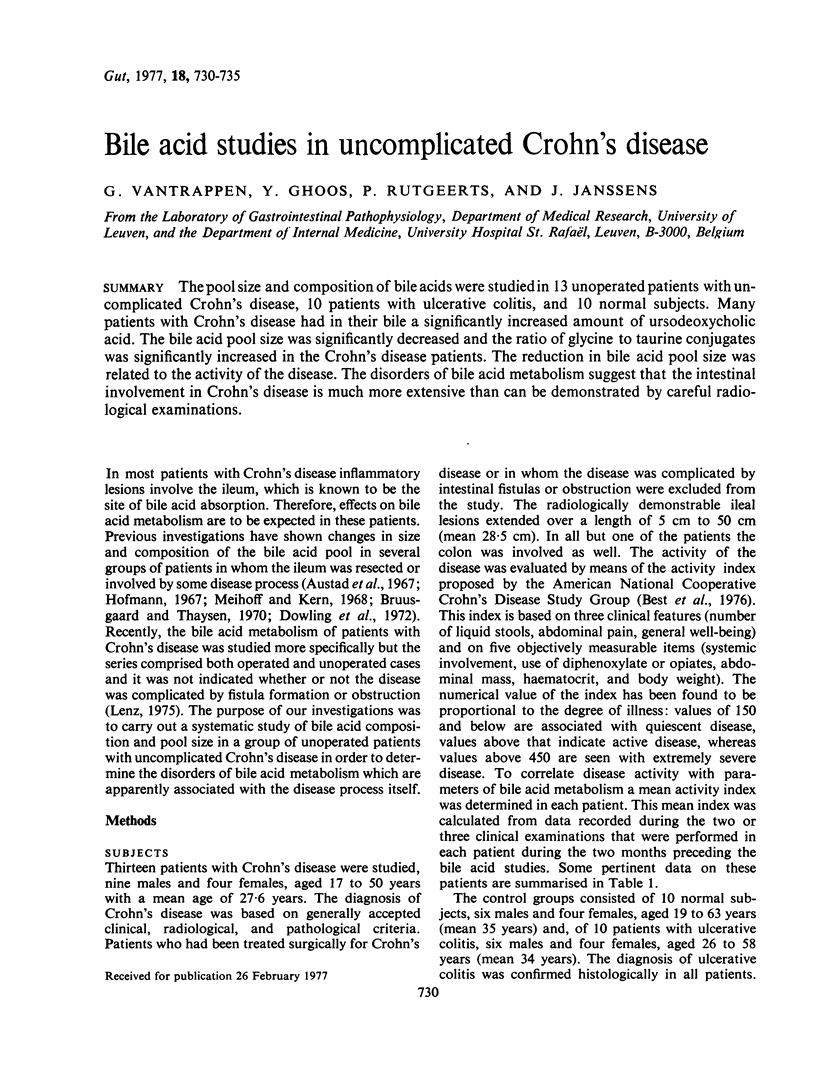
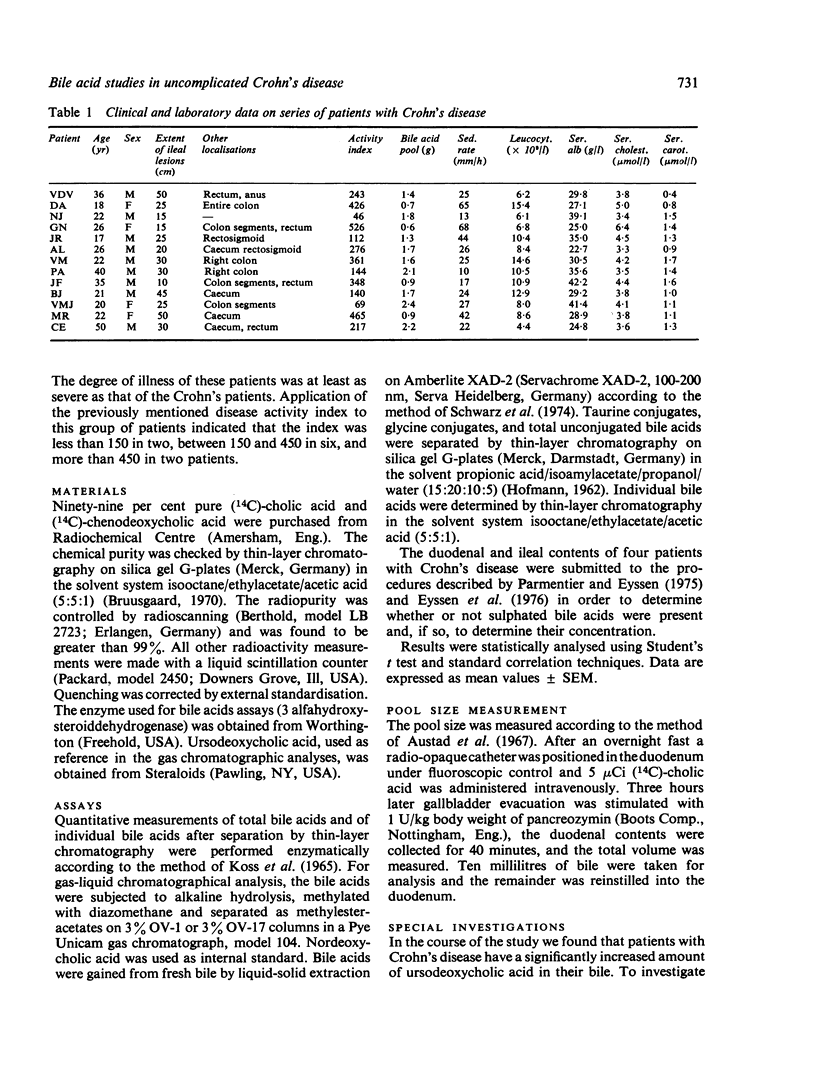
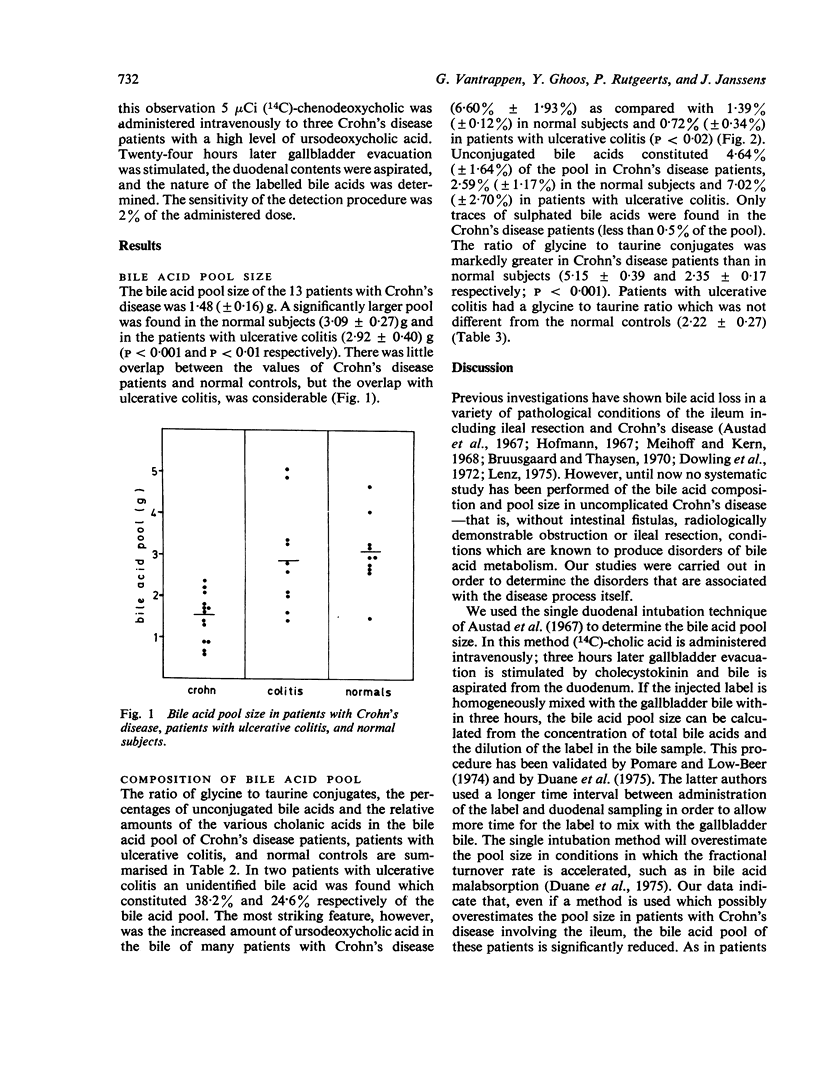
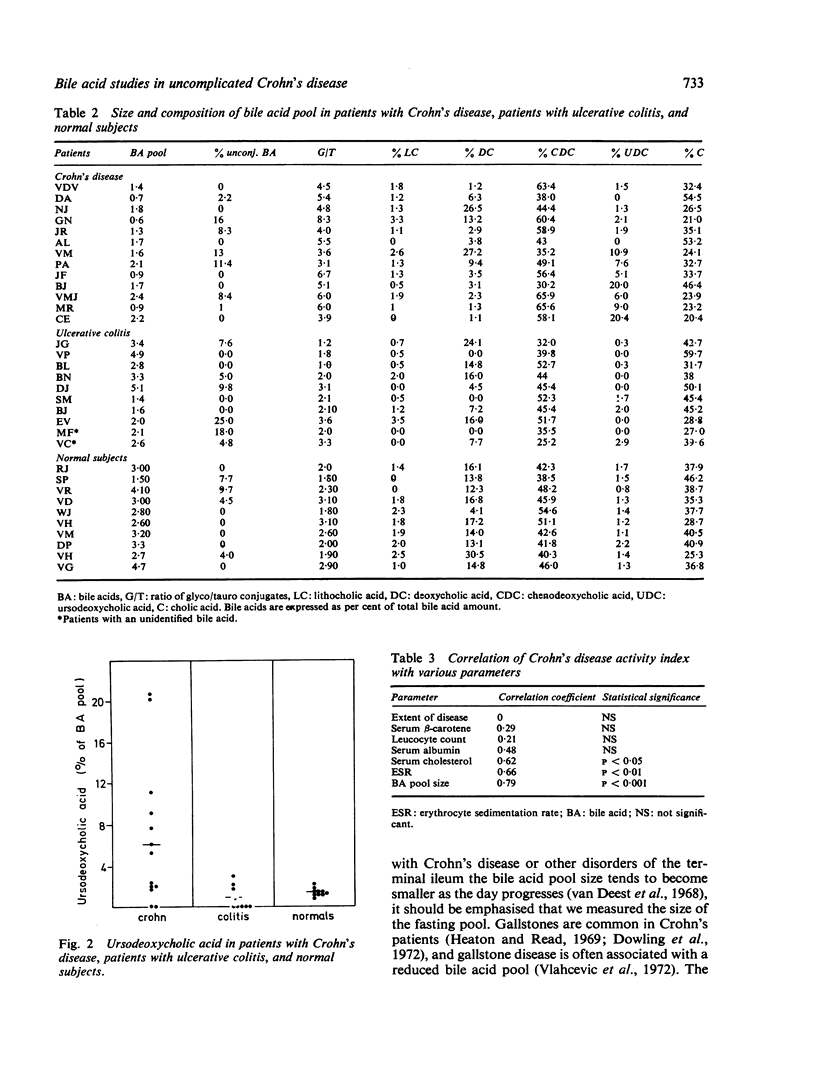
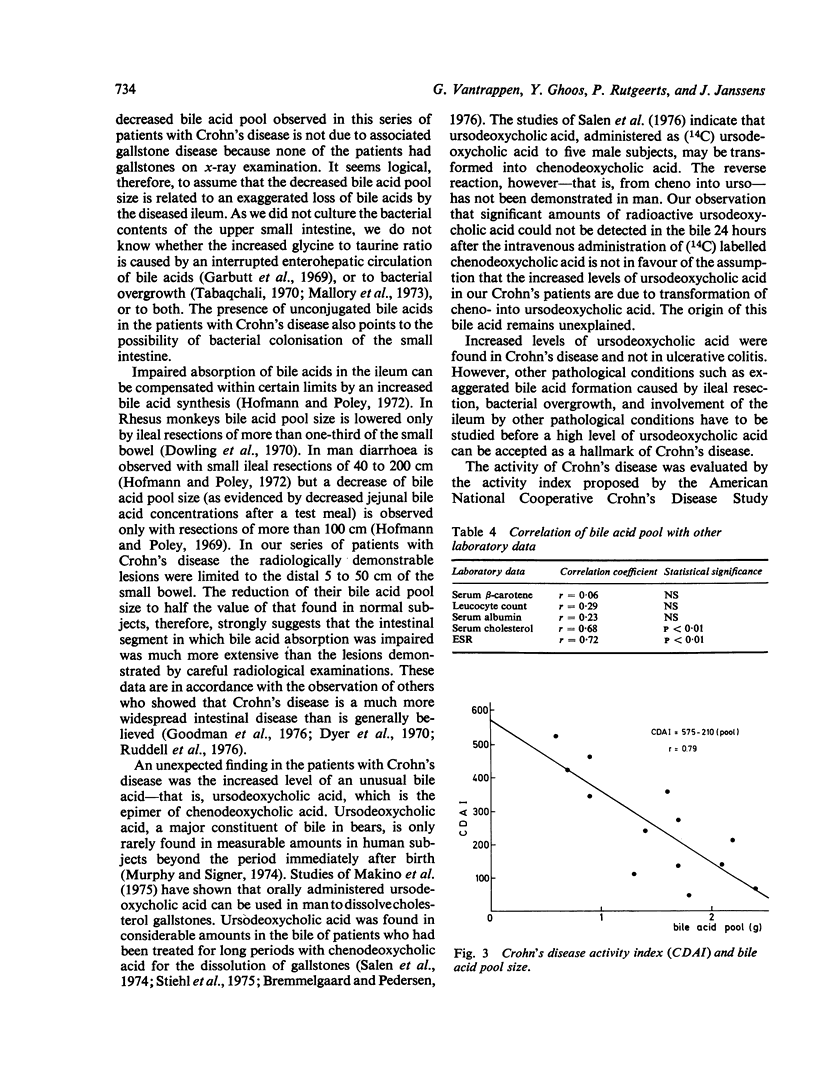

Selected References
These references are in PubMed. This may not be the complete list of references from this article.
- Austad W. I., Lack L., Tyor M. P. Importance of bile acids and of an intact distal small intestine for fat absorption. Gastroenterology. 1967 Apr;52(4):638–646. [PubMed] [Google Scholar]
- Best W. R., Becktel J. M., Singleton J. W., Kern F., Jr Development of a Crohn's disease activity index. National Cooperative Crohn's Disease Study. Gastroenterology. 1976 Mar;70(3):439–444. [PubMed] [Google Scholar]
- Bremmelgaard A., Pedersen L. Bile acids in bile during long-term chenodeoxycholic acid treatment. Scand J Gastroenterol. 1976;11(2):161–165. [PubMed] [Google Scholar]
- Bruusgaard A. Quantitative determination of the major 3-hydroxy bile acids in biological material after thin-layer chromatographic separation. Clin Chim Acta. 1970 Jun;28(3):495–504. doi: 10.1016/0009-8981(70)90078-1. [DOI] [PubMed] [Google Scholar]
- Bruusgaard A., Thaysen E. H. Increased ratio of glycine-taurine conjugated bile acids in the early diagnosis of terminal ileopathy. Preliminary report. Acta Med Scand. 1970 Dec;188(6):547–548. [PubMed] [Google Scholar]
- Dowling R. H., Bell G. D., White J. Lithogenic bile in patients with ileal dysfunction. Gut. 1972 Jun;13(6):415–420. doi: 10.1136/gut.13.6.415. [DOI] [PMC free article] [PubMed] [Google Scholar]
- Dowling R. H., Mack E., Small D. M. Effects of controlled interruption of the enterohepatic circulation of bile salts by biliary diversion and by ileal resection on bile salt secretion, synthesis, and pool size in the rhesus monkey. J Clin Invest. 1970 Feb;49(2):232–242. doi: 10.1172/JCI106232. [DOI] [PMC free article] [PubMed] [Google Scholar]
- Duane W. C., Adler R. D., Bennion L. J., Ginsberg R. L. Determination of bile acid pool size in man: a simplified method with advantages of increases precision, shortened analysis time, and decreased isotope exposure. J Lipid Res. 1975 Mar;16(2):155–158. [PubMed] [Google Scholar]
- Dyer N. H., Stansfeld A. G., Dawson A. M. The value of rectal biopsy in the diagnosis of Crohn's disease. Scand J Gastroenterol. 1970;5(6):491–496. [PubMed] [Google Scholar]
- Eyssen H. J., Parmentier G. G., Mertens J. A. Sulfate bile acids in germ-free and conventional mice. Eur J Biochem. 1976 Jul 15;66(3):507–514. doi: 10.1111/j.1432-1033.1976.tb10576.x. [DOI] [PubMed] [Google Scholar]
- Garbutt J. T., Heaton K. W., Lack L., Tyor M. P. Increased ratio of glycine- to taurine-conjugated bile salts in patients with ileal disorders. Gastroenterology. 1969 Apr;56(4):711–720. [PubMed] [Google Scholar]
- Goodman M. J., Skinner J. M., Truelove S. C. Abnormalities in the apparently normal bowel mucosa in Crohn's disease. Lancet. 1976 Feb 7;1(7954):275–278. doi: 10.1016/s0140-6736(76)91404-5. [DOI] [PubMed] [Google Scholar]
- Heaton K. W., Read A. E. Gall stones in patients with disorders of the terminal ileum and disturbed bile salt metabolism. Br Med J. 1969 Aug 30;3(5669):494–496. doi: 10.1136/bmj.3.5669.494. [DOI] [PMC free article] [PubMed] [Google Scholar]
- Hofmann A. F., Poley J. R. Role of bile acid malabsorption in pathogenesis of diarrhea and steatorrhea in patients with ileal resection. I. Response to cholestyramine or replacement of dietary long chain triglyceride by medium chain triglyceride. Gastroenterology. 1972 May;62(5):918–934. [PubMed] [Google Scholar]
- Hofmann A. F. The syndrome of ileal disease and the broken enterohepatic circulation: cholerheic enteropathy. Gastroenterology. 1967 Apr;52(4):752–757. [PubMed] [Google Scholar]
- Lenz K. An evaluation of the 'breath test' in Crohn's disease. Scand J Gastroenterol. 1975;10(6):665–671. [PubMed] [Google Scholar]
- Makino I., Shinozaki K., Yoshino K., Nakagawa S. [Dissolution of cholesterol gallstones by long-term administration of ursodeoxycholic acid]. Nihon Shokakibyo Gakkai Zasshi. 1975 Jun;72(6):690–702. [PubMed] [Google Scholar]
- Mallory A., Kern F., Jr, Smith J., Savage D. Patterns of bile acids and microflora in the human small intestine. I. Bile acids. Gastroenterology. 1973 Jan;64(1):26–33. [PubMed] [Google Scholar]
- Meihoff W. E., Kern F., Jr Bile salt malabsorption in regional ileitis, ileal resection and mannitol-induced diarrhea. J Clin Invest. 1968 Feb;47(2):261–267. doi: 10.1172/JCI105722. [DOI] [PMC free article] [PubMed] [Google Scholar]
- Murphy G. M., Signer E. Bile acid metabolism in infants and children. Gut. 1974 Feb;15(2):151–163. doi: 10.1136/gut.15.2.151. [DOI] [PMC free article] [PubMed] [Google Scholar]
- Parmentier G., Eyssen H. Synthesis of the specific monosulfates of cholic acid. Steroids. 1975 Dec;26(6):721–729. doi: 10.1016/0039-128x(75)90105-1. [DOI] [PubMed] [Google Scholar]
- Pomare E. W., Low-Beer T. S. Measurement and validation of human bile salt pool size and synthesis. Clin Chim Acta. 1974 Dec 17;57(3):239–248. doi: 10.1016/0009-8981(74)90403-3. [DOI] [PubMed] [Google Scholar]
- Ruddell W. S., Lovell D., Blendis L. M. Letter: Bowel mucosa in Crohn's disease. Lancet. 1976 Mar 6;1(7958):539–540. doi: 10.1016/s0140-6736(76)90325-1. [DOI] [PubMed] [Google Scholar]
- Salen G., Tint G. S., Eliav B., Deering N., Mosbach E. H. Increased formation of ursodeoxycholic acid in patients treated with chenodeoxycholic acid. J Clin Invest. 1974 Feb;53(2):612–621. doi: 10.1172/JCI107596. [DOI] [PMC free article] [PubMed] [Google Scholar]
- Tabaqchali S. The pathophysiological role of small intestinal bacterial flora. Scand J Gastroenterol Suppl. 1970;6:139–163. [PubMed] [Google Scholar]
- Talstad I., Gjone E. The disease activity of ulcerative colitis and Crohn's disease. Scand J Gastroenterol. 1976;11(4):403–408. [PubMed] [Google Scholar]
- Van Deest B. W., Fordtran J. S., Morawski S. G., Wilson J. D. Bile salt and micellar fat concentration in proximal small bowel contents of ileectomy patients. J Clin Invest. 1968 Jun;47(6):1314–1324. doi: 10.1172/JCI105823. [DOI] [PMC free article] [PubMed] [Google Scholar]
- Vlahcevic Z. R., Bell C. C., Jr, Gregory D. H., Buker G., Juttijudata P., Swell L. Relationship of bile acid pool size to the formation of lithogenic bile in female Indians of the southwest. Gastroenterology. 1972 Jan;62(1):73–83. [PubMed] [Google Scholar]


